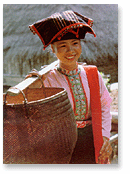Home » Tai
The Tai People

The Tai minority numbers just over 1 million, and is the dominant group in the northwest mountains from the Red River south to Nghe An, though most live in Lai Chau and Son La provinces. They are distantly related to the Thai of Thailand and to groups in southern China. their ancestral homeland. However, Thai people have been living in Vietnam for at least 2000 years and show similarities with both Viet and Tay cultures.
Traditional Thai society was strongly hierarchical, ruled over by feudal lords who controlled vast land-holdings worked by the villagers. Their written language. which is based on Sanskrit, has furnished a literary legacy dating back five centuries, including epic poems, histories and a wealth of folklore. The Thai are also famous for their unique dance repertoire and finely woven brocades decorated with flowers, birds and dragons, which are on sale in local markets.
From their early teens, women learn how to weave and embroider, eventually preparing a set of blankets for their dowry. Thai houses are often still constructed on stilts, with wood or bamboo frames, though the architecture varies between regions.
There are two main subgroups: Black Thai (around Dien Bien Phu, Tuan Giao and Son La) and White Thai (Mai Chau, Lai Chau, whose names are often attributed to the traditional colour of the women’s shirts, though this is open to dispute. In fact, the women of both groups tend to wear similar clothes, consisting of long sarong-like skirts, either black or very dark indigo blue, perhaps with a brightly coloured sash or brocade panels. Their shirts are fastened with beautiful silver clasps, fashioned in the shape of butterflies or other insects, and on formal occasions, they don intricately woven headscarves.
Theories vary in their actual relation to the Thais of Siam (Thailand), as do the reference to colours in the sub-groupings such as the Red, Black and White Tai. Some contend that the colours coincide with those of the women’s skirts, while others believe the names come from the nearby Black and Red Rivers. Villages typically have 40 to 50 bamboo-stilt households. Tai women don close-fitting black skirts, blouses with silver clasps and colourful robes and kerchiefs and are also known for creating beautiful embroidery. The Tai, using a script developed in the 5th century, have produced literature ranging from poetry and love stories to folk tales and songs, and are renowned for their celebrations of music and dance. Like the Tay, the Tai originated in southern China and reside mainly in the north-west. They settled along fertile riverbeds, which serve as the source of irrigation for fields of rice, corn, cotton, beans and so on.

